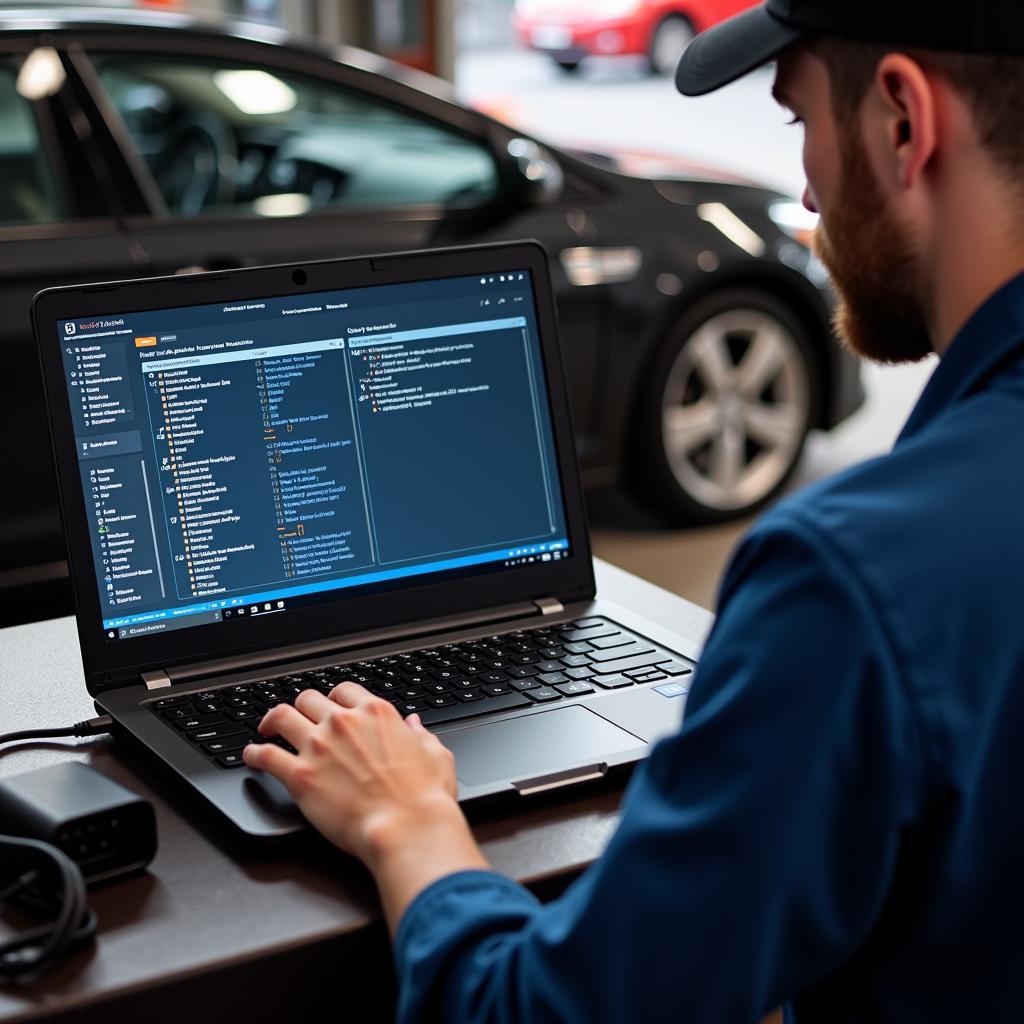Finding the best diagnostic software for your laptop can feel like navigating a maze. With so many options available, it’s easy to get lost in technical jargon and conflicting reviews. Whether you’re a seasoned mechanic or a car enthusiast looking to DIY, this guide will equip you with the knowledge to make an informed decision.
Why You Need Car Diagnostic Software
Modern vehicles are complex machines with intricate electronic systems. When something goes wrong, pinpointing the issue can be like finding a needle in a haystack without the right tools. This is where car diagnostic software comes in.
 Car Diagnostic Software in Action
Car Diagnostic Software in Action
This software acts as a window into your car’s computer, allowing you to:
- Read and clear diagnostic trouble codes (DTCs): These codes, often appearing as a “check engine” light, signal a problem within your car’s systems. Diagnostic software decodes these cryptic codes into understandable language, revealing the root of the issue.
- View live data streams: Monitor various parameters like engine RPM, coolant temperature, and oxygen sensor readings in real-time. This information is invaluable for diagnosing intermittent problems or understanding how your car performs under different conditions.
- Perform advanced functions: Depending on the software and vehicle, you can access functions like resetting service lights, reprogramming keys, or even performing component activations for more in-depth diagnostics.
Choosing the Right Software: Key Factors to Consider
Before diving into the best diagnostic software options, let’s outline the key factors to consider when making your choice:
- Vehicle Compatibility: Ensure the software supports your car’s make, model, and year. Some software focuses on specific manufacturers, while others offer broader coverage.
- Features: Determine the features essential for your needs. Do you need basic code reading and clearing, or are you looking for advanced functionalities like bi-directional control or ECU coding?
- User Interface: Opt for software with a user-friendly interface, especially if you’re a beginner. Look for intuitive menus, clear data presentation, and helpful resources like built-in troubleshooting guides.
- Price: Diagnostic software prices vary widely, from budget-friendly options to professional-grade tools. Set a budget beforehand and choose software that offers the best value for your needs.
- Updates: Regular software updates are crucial for compatibility with new vehicle models and features. Choose software with a proven track record of timely updates and ongoing support.
Top Diagnostic Software Options for Your Laptop
Now, let’s explore some of the best car diagnostic software available:
1. Professional-Grade Powerhouses
- [Software A]: Known for its comprehensive coverage, advanced functionalities, and robust reporting capabilities. This software is ideal for professional mechanics and experienced DIYers who demand the best.
- [Software B]: Offers extensive vehicle compatibility, including European and Asian makes. It boasts a user-friendly interface and provides in-depth technical information, making it suitable for both professionals and enthusiasts.
2. Budget-Friendly Contenders
- [Software C]: Provides excellent value for its price, offering basic to intermediate-level functionalities. It’s a solid choice for DIYers and car owners looking to perform basic diagnostics and maintenance tasks.
- [Software D]: This cloud-based software offers affordable subscription plans and works seamlessly across multiple devices. It’s a convenient option for users who value accessibility and regular updates.
 Mechanic Analyzing Diagnostic Data
Mechanic Analyzing Diagnostic Data
Getting the Most Out of Your Diagnostic Software
Choosing the right software is just the first step. Here are some tips to maximize its potential:
- Invest in a Quality OBD-II Adapter: The OBD-II adapter acts as the bridge between your laptop and your car’s computer. Opt for a reliable adapter with good reviews to ensure stable communication and accurate data transmission.
- Familiarize Yourself with the Software: Take the time to explore the software’s features, menus, and settings. Many software providers offer tutorials, FAQs, and user forums to assist you.
- Start with Basic Diagnostics: If you’re new to car diagnostics, begin with basic code reading and clearing. As you gain confidence, gradually explore more advanced functionalities.
- Don’t Hesitate to Seek Help: If you encounter difficulties or have questions, don’t hesitate to consult the software’s documentation, online forums, or contact their support team.
Conclusion
Investing in the best diagnostic software for your laptop can empower you to take control of your car’s health. By understanding your needs, researching available options, and following these tips, you can find the perfect software to unlock your inner mechanic and keep your car running smoothly. Looking for the best diagnostic tools for your needs? Check out our comprehensive guide on the best diagnostic tools for cars.

Leave a Reply